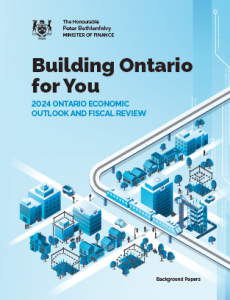 Minister of Finance Peter Bethlenfalvy released the 2024 Ontario Economic Outlook and Fiscal Review: Building Ontario for You. The government continues to take a fiscally responsible approach towards building the critical infrastructure our growing communities need, reducing gridlock, and making life more affordable by keeping taxes low and putting more money back in your pocket.
Minister of Finance Peter Bethlenfalvy released the 2024 Ontario Economic Outlook and Fiscal Review: Building Ontario for You. The government continues to take a fiscally responsible approach towards building the critical infrastructure our growing communities need, reducing gridlock, and making life more affordable by keeping taxes low and putting more money back in your pocket.
“Our government’s responsible approach has resulted in an improved fiscal position since the 2024 Budget, allowing us to keep taxes low, invest in infrastructure like roads, highways, hospitals and schools, and provide immediate relief to Ontario families as part of our plan to keep costs down,” said Minister Bethlenfalvy. “We’re going to continue investing responsibly to support Ontario’s growth and rebuild Ontario’s economy to make our province the best place to live, work and raise a family, all while reducing the debt burden for future generations.”
The government’s plan reduces the deficit and retains a path to balance the budget by 2026–27, even with uncertain global economic conditions and other headwinds beyond the government’s control. Compared to the 2024 Budget, Ontario is also projected to see both stronger growth in real GDP and employment in 2024.
Highlights of how the government is keeping costs down in the 2024 Fall Economic Statement include:
- Providing a $200 taxpayer rebate early next year, which would give immediate relief for Ontario families in the face of high interest rates and the federal carbon tax. This proposed $200 taxpayer rebate would be sent to all eligible adults in Ontario who have filed their 2023 Income Tax and Benefit Return by December 31, 2024. Eligible families would receive an additional $200 for each child under 18.
- Proposing to further extend the temporary gas tax and fuel tax rate cuts so that the rate of tax on gasoline and fuel (diesel) would remain at 9 cents per litre until June 30, 2025. This would save Ontario households $380, on average, over the three years since July 2022. This relief is especially important as the federal carbon tax is set to increase again on April 1, 2025.
- Starting in 2026, the government is investing an estimated $88 million over three years to expand Learn and Stay grants for 1,360 eligible undergraduate students that commit to practise family medicine with a full roster of patients once they graduate. This includes $17.7 million for the 2026–27 academic year. It is estimated the total investment will enable the connection of an additional 1.36 million people to primary care based on average attachment rates for family doctors. The funding will cover all tuition and other direct educational costs like books, supplies and equipment in exchange for a term of service as a physician in any community across Ontario.
- Expanding access for families who are seeking fertility treatment. Beginning in 2025–26, the government will invest an additional $150 million over two years to expand the Ontario Fertility Program (OFP). This funding will nearly triple the number of individuals who are able to receive a government-funded in vitro fertilization (IVF) cycle, increasing the capacity of fertility clinics and reducing waitlists in hospitals and community settings. In 2025, the government will introduce additional support to families who are seeking fertility treatment through a new tax credit, which would provide support of up to 25 per cent of eligible fertility treatment expenses for Ontario residents, up to a maximum of $5,000 per year, which could include IVF cycles, fertility drugs, travel for treatment and diagnostic testing. The government is setting aside $115 million for this initiative over three years.
- Increasing the Ontario Municipal Partnership Fund (OMPF) — the province’s main general assistance grant to municipalities — by $100 million over the next two years, bringing total funding provided through this program to $600 million by 2026. In 2025, municipalities will benefit from an immediate $50 million increase to the OMPF.
“We’re delivering on our plan to rebuild Ontario’s economy, creating better jobs and bigger paycheques for Ontario workers, while keeping costs down for families and businesses,” said Minister Bethlenfalvy. “We’re supporting workers, families and municipalities, investing in their success to create stronger communities and better opportunities for years to come.”
Quick Facts
- The government is now projecting a deficit of $6.6 billion in 2024–25 — an improvement of $3.2 billion from the outlook published in the 2024 Budget. This reflects updated economic and revenue information and higher contingencies to mitigate near-term risks.
- Over the medium term, the government projects a deficit of $1.5 billion in 2025–26, followed by a surplus of $0.9 billion in 2026–27.
- Ontario’s net debt-to-GDP ratio for 2024–25 is projected to be 37.8 per cent. Over the medium term, the net debt-to-GDP ratio is forecast to be 37.9 per cent in 2025–26 and 37.5 per cent in 2026–27.
- Ontario’s historic infrastructure investment includes over $191 billion over the next decade to build and improve transit, highways, housing-enabling infrastructure, hospitals, schools, long-term care facilities and other critical public infrastructure.
- On November 14, 2024, the government will launch consultations to help inform the 2025 Budget and hear from Ontarians on the most pressing challenges of today, such as making life more affordable, building more homes, schools, and creating good jobs for Ontario workers.
- Ontario and Marten Falls First Nation Sign Historic Agreement to Unlock Ring of Fire - November 28, 2025
- Ontario Investing in Winter Roads Network - November 25, 2025
- Ontario Launches Feasibility Study to Build East-West Pipeline and Energy Corridor - November 3, 2025
 Wawa-news.com You can't hear the 'big picture'!
Wawa-news.com You can't hear the 'big picture'!


